» Site Map
» Home Page
Historical Info
» Find Friends - Search Old Service and Genealogy Records
» History
» QAIMNS for India
» QAIMNS First World War
» Territorial Force Nursing Service TFNS
» WW1 Soldiers Medical Records
» Field Ambulance No.4
» The Battle of Arras 1917
» The German Advance
» Warlencourt Casualty Clearing Station World War One
» NO 32 CCS Brandhoek - The Battle of Passchendaele
» Chain of Evacuation of Wounded Soldiers
» Allied Advance - Hundred Days Offensive
» Life After War
» Auxiliary Hospitals
» War Graves Nurses
» Book of Remembrance
» Example of Mentioned in Despatches Letter
» Love Stories
» Autograph Book World War One
» World War 1 Letters
» Service Scrapbooks
» QA World War Two
» Africa Second World War
» War Diaries of Sisters
» D Day Normandy Landings
» Belsen Concentration Camp
» Italian Sailor POW Camps India World War Two
» VE Day
» Voluntary Aid Detachment
» National Service
» Korean War
» Gulf War
» Op Telic
» Op Gritrock
» Royal Red Cross Decoration
» Colonels In Chief
» Chief Nursing Officer Army
» Director Army Nursing Services (DANS)
» Colonel Commandant
» Matrons In Chief (QAIMNS)
Follow us on Twitter:

» Grey and Scarlet Corps March
» Order of Precedence
» Motto
» QA Memorial National Arboretum
» NMA Heroes Square Paving Stone
» NMA Nursing Memorial
» Memorial Window
» Stained Glass Window
» Army Medical Services Monument
» Recruitment Posters
» QA Association
» Standard
» QA and AMS Prayer and Hymn
» Books
» Museums
Former Army Hospitals
UK
» Army Chest Unit
» Cowglen Glasgow
» CMH Aldershot
» Colchester
» Craiglockhart
» DKMH Catterick
» Duke of Connaught Unit Northern Ireland
» Endell Street
» First Eastern General Hospital Trinity College Cambridge
» Ghosts
» Hospital Ghosts
» Haslar
» King George Military Hospital Stamford Street London
» QA Centre
» QAMH Millbank
» QEMH Woolwich
» Medical Reception Station Brunei and MRS Kuching Borneo Malaysia
» Military Maternity Hospital Woolwich
» Musgrave Park Belfast
» Netley
» Royal Chelsea Hospital
» Royal Herbert
» Royal Brighton Pavilion Indian Hospital
» School of Physiotherapy
» Station Hospital Ranikhet
» Station Hospital Suez
» Tidworth
» Ghost Hunt at Tidworth Garrison Barracks
» Wheatley
France
» Ambulance Trains
» Hospital Barges
» Ambulance Flotilla
» Hospital Ships
Germany
» Berlin
» Hamburg
» Hannover
» Hostert
» Iserlohn
» Munster
» Rinteln
» Wuppertal
Cyprus
» TPMH RAF Akrotiri
» Dhekelia
» Nicosia
Egypt
» Alexandria
China
» Shanghai
Hong Kong
» Bowen Road
» Mount Kellett
» Wylie Road Kings Park
Malaya
» Kamunting
» Kinrara
» Kluang
» Penang
» Singapore
» Tanglin
» Terendak
Overseas Old British Military Hospitals
» Belize
» Falklands
» Gibraltar
» Kaduna
» Klagenfurt
» BMH Malta
» Nairobi
» Nepal
Middle East
» Benghazi
» Tripoli
Field Hospitals
» Camp Bastion Field Hospital and Medical Treatment Facility MTF Helmand Territory Southern Afghanistan
» TA Field Hospitals and Field Ambulances
Hospital Barges
History of the First World War Hospital Barges used by the British Army on the River Seine and canals in France and Belgium to evacuate casualties:
During World War One casualties were evacuated by train, boat and barge. The hospital barges were much slower, but did make for a smoother and more gentle journey. Though the journey took longer it did allow for the Queen Alexandra's Imperial Military Nursing Service nurses to tend to the injuries of the wounded soldiers and perform daily dressings and for the troops to recuperate from their wounds and the effects of war.
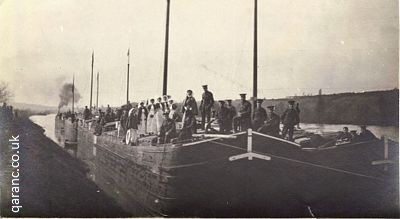
In the Company of Nurses: The History of the British Army Nursing Service in the Great War
The war diary of Queen Alexandra's Imperial Military Nursing Service Reserve (QAIMNSR) staff nurse Miss Mildred Rees can be read in Women in the War Zone: Hospital Service in the First World War
The book Sub Cruce Candida: A Celebration of One Hundred Years of Army Nursing
The hospital barges were not specifically built or designed for troop evacuation or as a hospital until a few years into the Great War. Instead they were converted from a range of general use barges such as coal or cargo barges. Access hatches would be cut into the roofs and hand operated lifts built so that stretcher cases could be lowered to the hold. The lift would be operated by the cook when additional help was needed. The holds would be converted into 30 bedded hospital wards and QAIMNS nurses accommodation. These sleeping and living quarters were heated by two stoves and electric lighting was fitted to the barges and electric fans could be run in the French and Belgian heat of summer or the hatches lifted off areas of the roofs.
The book It's a Long Way to Tipperary: British and Irish Nurses in the Great War
The electric lights would be turned off at night to avoid being an easy target for German fighter pilots. Nurses would have to make their rounds in the pitch dark using a small torch. The nights could be long but did provide some rest for the other staff because the hospital barges would only travel during the daylight hours because they had to pass through narrow under bridges which often only had inches to spare. Negotiating these tight under bridges was much easier in the light of day.
From the outside the hospital barges were painted grey with a large red cross on each side to signify that they were non combatant and carrying wounded soldiers. The interior of each hospital barge was painted white. Ventilation was provided by ventilators in the side of the roofs and as the war progressed sky lights were built into the barges.
The sailing skipper of each hospital barge was usually a Royal Engineer (RE) sergeant and the barges would be towed by steam tugs.
Follow us on Facebook, Instagram and Twitter.
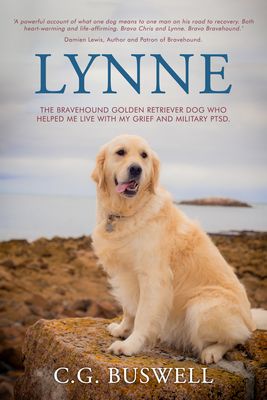
My PTSD assistance dog, Lynne, and I have written a book about how she helps me with my military Post Traumatic Stress Disorder, anxiety, and depression. I talk about my time in the QAs and the coping strategies I now use to be in my best health.
Along the way, I have had help from various military charities, such as Help for Heroes and The Not Forgotten Association and royalties from this book will go to them and other charities like Bravehound, who paired me with my four-legged best friend.
I talk openly about the death of my son by suicide and the help I got from psychotherapy and counselling and grief charities like The Compassionate Friends.
The author, Damien Lewis, said of Lynne:
"A powerful account of what one dog means to one man on his road to recovery. Both heart-warming and life-affirming. Bravo Chris and Lynne. Bravo Bravehound."
Download.
Buy the Paperback.
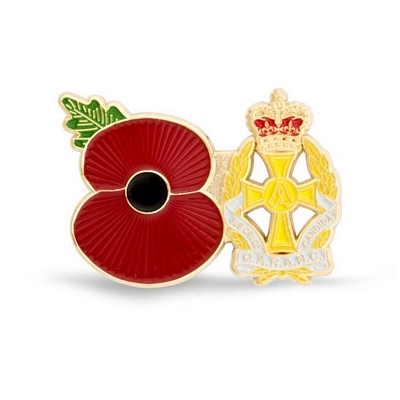
This beautiful QARANC Poppy Pin Badge is available from the Royal British Legion Poppy Shop.
For those searching military records, for information on a former nurse of the QAIMNS, QARANC, Royal Red Cross, VAD and other nursing organisations or other military Corps and Regiments, please try Genes Reunited where you can search for ancestors from military records, census, birth, marriages and death certificates as well as over 673 million family trees. At GenesReunited it is free to build your family tree online and is one of the quickest and easiest ways to discover your family history and accessing army service records.
More Information.
Another genealogy website which gives you access to military records and allows you to build a family tree is Find My Past which has a free trial.
No 1 Ambulance Flotilla
The photos of hospital barges on this page come from the collection of Acting Matron Kate Read who served for 6 months in 1915 (May to October) on No.1 Ambulance Flotilla. Sister Kate Read also served for 6 months each at No.6 General Hospital Rouen, 18 Casualty Clearing Station and 32 CCS ending up with 3 months at No.6 CCS before leaving the army to marry.
The photograph above is the exterior view of No.1 Ambulance Flotilla being towed on the Seine by a tug with medical staff posing on the pair of barges at the rear, The photograph shows all three pairs of barges, each with their flagpoles flying the Red Cross and one red cross can be seen on the side of the nearest barge.
This next picture shows the interior of a ward with one of the stoves and the central electric light common to hospital barges of World War One.
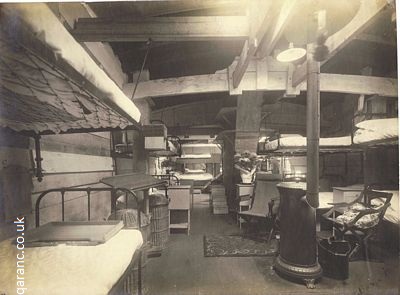
This picture of the No 1 Ambulance Flotilla Staff show Colonel & Mrs Yate with medical staff. Sister Read has written the names of the staff, nurses and doctors, on the back of this photo. It reads from left to right
1st row as: M. Gossip med. Officer, Col. Yate M.P., M. Greenfield med. Officer, Capt. Bowles The skipper, M. Boyle M.P. (a bit of him only), M. Mulholland med. Officer and M. Grant M.P.
2nd row: Sister Coulson, Sister Mills, Mrs. Yate, Capt. OGrady, Matron [Acting Matron Kate Read], Sister Bayly.
3rd Row: Sister Cooke, Sister Draper, M. Sainsbury, Sister Cameron and Sister Gibbens.
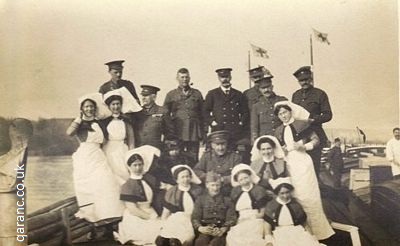
The wooden deck of the barge could be slippery when wet and it was common for a QA to end up in the canal water! This was usually in the winter with the rain and ice and the awaiting canals freezing water. Many nurses and orderlies would solve the problem of the slippery decks by overcoming their embarrassment and crawling along on all fours.
Though there were happy times aboard hospital barges such as sing a longs when the gramophone was played or in finer weather when the soldiers and nursing staff would sit on the decks and the roofs with fishing rods in the hope of catching some fish for supper. Many QAs would enjoy the sunshine on the roof, still dressed in their ankle length ward dresses, stockings, capes and veils with only their faces and hands exposed to the French sun!
During periods of rain the roofs would leak and the nurses and orderlies would have to keep moving the patients beds to avoid the larger drips of rain water.
Some hospital barges kept pets to help keep up the morale of patients, nurses and staff. Cats were a common pet or mascot and It's a Long Way to Tipperary: British and Irish Nurses in the Great War
The hospital barges usually travelled in pairs down the River Seine and the French canals in the British controlled zones to the evacuation ports or to casualty clearing stations and base hospitals. There would usually be at least one QA Sister, staff nurse and Royal Army Medical Corps (RAMC) orderly per hospital barge. At the height of World War One there were five flotillas of hospital barges. Each flotilla had six hospital barges which would travel in pairs. Each pair of travelling hospital barges would be commanded by an RAMC Medical Officer, usually of Captain rank. The barges that sailed with a full load of patients would have a staff compliment of one QA nursing officer, a staff nurse, an RAMC sergeant, corporal, three nursing assistants, two general orderlies, a cook and a cook's assistant.
Staff would be stationed to the hospital barge and had accommodation on the barge. When the patients were offloaded from the barge there was no time to rest. The barge had to be thoroughly cleaned, especially since as the war progressed many soldiers were evacuated straight to a hospital barge rather than a field hospital or dressing station. These soldiers were often ridden with lice and were filthy coming straight from the trenches and battlefield.
There was often problems with the gas attacked patients. The smell of gas would remain on their clothing and breath and even in their wounds, especially when blisters burst. The lack of ventilation meant that nurses, other patients and staff would suffer a mild gas attack that caused problems such as sickness, watery or sore eyes and breathing problems.
The rations, general stores, medicines, dressing etc had to be restocked and when the opportunity arose staff would be sent to a nearby town to buy fresh food such as fruit and vegetables.

Former Royal Air Force Regiment Gunner Jason Harper witnesses a foreign jet fly over his Aberdeenshire home. It is spilling a strange yellow smoke. Minutes later, his wife, Pippa, telephones him, shouting that she needs him. They then get cut off. He sets straight out, unprepared for the nightmare that unfolds during his journey. Everyone seems to want to kill him.
Along the way, he pairs up with fellow survivor Imogen. But she enjoys killing the living dead far too much. Will she kill Jason in her blood thirst? Or will she hinder his journey through this zombie filled dystopian landscape to find his pregnant wife?
The Fence is the first in this series of post-apocalyptic military survival thrillers from the torturous mind of former British army nurse, now horror and science fiction novel writer, C.G. Buswell.
Download Now.
Buy the Paperback.
If you would like to contribute to this page, suggest changes or inclusions to this website or would like to send me a photograph then please e-mail me.
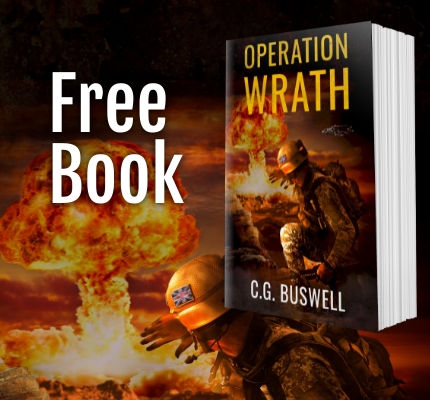
Free Book.
The death of the Brotherhood will be avenged.
RAF gunner Jason Harper and a team of Special Air Service operators are enraged after the death of their brothers by a terrorist drone strike. They fly into south-eastern Yemen on a Black-op mission to gather intelligence and avenge the death of their comrades.
Can they infiltrate the Al-Queda insurgents' camp, stay undetected, and call down their own drone missile strike and get home safely?
Will they all survive to fight another day?
Operation Wrath is a free, fast-paced adventure prequel to the non-stop action The Fence series by military veteran author C.G. Buswell.
Download for free on any device and read today.
This website is not affiliated or endorsed by The Queen Alexandra's Royal Army Nursing Corps (QARANC) or the Ministry of Defence.
» Contact
» Advertise
» QARANC Poppy Pin
» Poppy Lottery
» The Grey Lady Ghost of the Cambridge Military Hospital Novel - a Book by CG Buswell
» The Drummer Boy Novel
» Regimental Cap Badges Paintings
Read our posts on:
Offers
» Army Discounts
» Claim Uniform Washing Tax Rebate For Laundry
» Help For Heroes Discount Code
» Commemorative Cover BFPS 70th anniversary QARANC Association

Present Day
» Become An Army Nurse
» Junior Ranks
» Officer Ranks
» Abbreviations
» Nicknames
» Service Numbers
Ministry of Defence Hospital Units
» MDHU Derriford
» MDHU Frimley Park
» MDHU Northallerton
» MDHU Peterborough
» MDHU Portsmouth
» RCDM Birmingham
» Army Reserve QARANC
Photos
» Florence Nightingale Plaque
» Photographs
Uniform
» Why QA's Wear Grey
» Beret
» Army Medical Services Tartan
» First Time Nurses Wore Trousers AV Anti Vermin Battledress
» TRF Tactical Recognition Flash Badge
» Greatcoat TFNS
» Lapel Pin Badge
» Army School of Psychiatric Nursing Silver Badge
» Cap Badge
» Corps Belt
» ID Bracelet
» Silver War Badge WWI
» Officer's Cloak
» QAIMNSR Tippet
» QAIMNS and Reserve Uniform World War One
» Officer Medal
» Hospital Blues Uniform WW1
Events
» Armed Forces Day
» The Nurses General Dame Maud McCarthy Exhibition Oxford House London
» Edinburgh Fringe Stage Play I'll Tell You This for Nothing - My Mother the War Hero
» Match For Heroes
» Recreated WWI Ward
» Reunions
» Corps Day
» Freedom of Rushmoor
» Re-enactment Groups
» Military Events
» Remembrance
» AMS Carol Service
» QARANC Association Pilgrimage to Singapore and Malaysia 2009
» Doctors and Nurses at War
» War and Medicine Exhibition
» International Conference on Disaster and Military Medicine DiMiMED
» QA Uniform Exhibition Nothe Fort Weymouth
Famous QA's
» Dame Margot Turner
» Dame Maud McCarthy
» Lt Col Maureen Gara
» Military Medal Awards To QAs
» Moment of Truth TV Documentary
» Sean Beech
» Staff Nurse Ella Kate Cooke
Nursing
Nursing Jobs Vacancies UK
International Nurses Day
International Midwife Day
Info
» Search
» Site Map
» Contact
» Other Websites
» Walter Mitty Military Imposters
» The Abandoned Soldier
We are seeking help with some answers to questions sent by readers. These can be found on the Army Nursing page.
» Find QA's
» Jokes
» Merchandise
» Mugs
» Personalised Poster
» Poppy Badges
» Stamp
» Teddy Bears
» Pin Badges
» Wall Plaques
» Fridge Magnet

